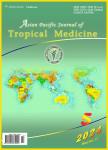Chemical analysis and in vitro antimicrobial effects and mechanism of action of Trachyspermum copticum essential oil against Escherichia coli
Chemical analysis and in vitro antimicrobial effects and mechanism of action of Trachyspermum copticum essential oil against Escherichia coli作者机构:Tianjin University of Science & Technology China Packaging Research&Test Center
出 版 物:《Asian Pacific Journal of Tropical Medicine》 (亚太热带医药杂志(英文版))
年 卷 期:2017年第10卷第7期
页 面:726-732页
核心收录:
学科分类:1002[医学-临床医学] 1001[医学-基础医学(可授医学、理学学位)] 100103[医学-病原生物学] 10[医学]
基 金:supported by the ‘13th Five-Year’ scientific research and innovation team of Tianjin University of Science&Technology(green food packaging and intelligent packaging) the ‘12th Five-Year’ National Science and Technology Support Project of People's Republic of China(Grant No.2015BAD16B05-02)
主 题:Essential oil Trachyspermum copticum Antimicrobial activity GC/MS Escherichia coli Mechanism
摘 要:Objective: To find a natural plant essential oil(EO) with excellent antimicrobial effect on food-borne bacteria and to explore the mechanism of its antimicrobial function against Escherichia coli(E. coli). Methods: The antimicrobial activity of seven EOs against Gramnegative E. coli ATCC 8739 and Gram-positive Staphylococcus aureus ATCC 6538 was investigated using agar disk diffusion method, and the minimum inhibitory concentration(MIC) and minimum bactericidal concentration(MBC) of each EO was determined using the broth dilution method. The chemical composition of the Trachyspermum copticum(T. copticum) EO was analyzed using gas chromatography–mass spectrometry(GC/MS). In order to explore the mechanism of the antimicrobial action, 1 MIC and 2 MIC of T. copticum EO was added to a suspension of E. coli, the growth curve and the scanning electron microscopy(SEM) analysis of E. coli, and the release of cell constituents and protein and potassium ions from the bacterial cell were measured. Results: The T. copticum EO had the best antimicrobial activity against the test bacteria, and 10 compounds accounting for 94.57% of the total oil were identified, with the major components being thymol(46.22%), p-cymene(19.03%), and 毭-terpinene(22.41%). The addition of 1 MIC T. copticum EO significantly inhibited the growth of E. coliand increased the release of cell constituents and protein and potassium ions from the bacterial cells. Scanning electron micrographs showed that T. copticum EO caused most of the E. colicell membranes to collapse and rupture, leading to cell death. Conclusions: These results indicate that T. copticum EO is a good natural antimicrobial agent for food-borne pathogens.



